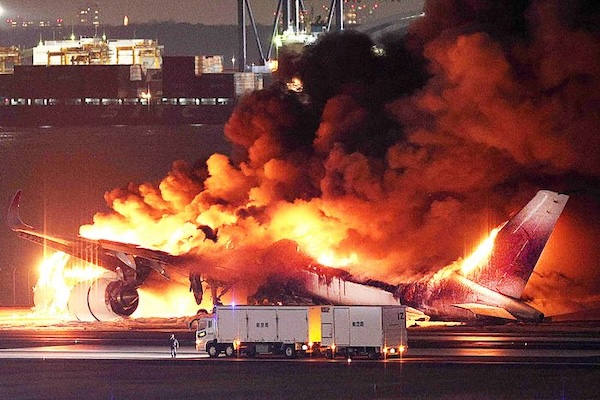It was exactly the kind of disaster scenario that aviation-safety experts have been warning could happen. A pilot, apparently disoriented, taxis his aircraft onto an active runway right into the path of an inbound, heavily loaded airliner. Unable to react in time, the pilot of the landing plane collides head-on into the first plane. The ensuing fireball envelops both aircraft.
Accidents like this, called “runway incursions,” can be extremely dangerous. The deadliest crash in aviation remains a collision between two 747s that took place on a foggy runway in the Canary Islands in 1977, which killed 583 of the 644 people aboard the planes.
It is all the more remarkable, then, that there were no fatalities and just 11 injuries aboard the Japan Airlines A350 that crashed into a Japan Coast Guard Dash 8 at Tokyo’s Haneda Airport on Tuesday. The situation aboard the Dash 8 was much worse, killing five of the six crew members aboard.
The fact that the outcome was relatively benign is a testament to the advances in engineering that have been incorporated into the latest generation of airliners, as well as to the safety culture that infuses a top-quality carrier like Japan Airlines. But the remarkable extent to which passengers’ lives were protected — this event merits the word “miracle” as much as Captain Sullenberger’s 2009 landing on the Hudson does — shouldn’t overshadow the profound problems revealed by the fact that the accident occurred at all. Unless there are major changes in protocol and technology, this kind of crash will happen again, quite likely with deadlier results.
Here’s what we know so far. JAL flight 512 was inbound to Tokyo from Hokkaido, Japan’s northernmost major island, on a short-haul flight of just two hours’ duration. A350s are big, wide-body aircraft that in most parts of the world are used for long-haul flights like Hong Kong to Los Angeles, but Japan has long used big aircraft to move lots of people quickly, to compete with the country’s excellent high-speed rail system. They pack them in tight: Whereas an A350 configured for long-haul flights might carry only 300 passengers, JAL 512 was carrying 367, along with 12 crew members.
The airliner approached Haneda from the south and touched down on runway 34R. Apparently, the pilots either failed to see or didn’t have time to react to the De Havilland Canada DHC-8 that had taxied out into its path. The Dash 8, a twin-engine turboprop often used by feeder airlines for short-hop flights, was reportedly headed to western Japan to assist in relief efforts following a massive earthquake that struck the day before.
Video footage of the impact shows a fireball erupting, then the A350 emerging from the flames with its nose and engine cowlings skidding along the runway, its nose landing gear apparently having collapsed during the collision. After it slid to a halt, passengers descended inflatable slides and ran for safety as flames licked the rear of the aircraft, then gradually spread to consume the fuselage.
The accident marks the first time that an A350 has been destroyed since its introduction in 2015, so it will be closely studied for lessons in how this type of aircraft fares under extreme stress. Like the world’s second-newest wide-body, Boeing’s 787, which entered service in 2011, the A350 is built largely of carbon-fiber composite, rather than aluminum like older aircraft. As such, it is both lightweight and rugged, as testified by the fact that after its collision with the Dash 8, the front of the A350’s nose was smashed in but the rest of the forward part of the aircraft, including the cockpit, looked largely unscathed. Unlike aluminum, carbon does burn, but the resin-impregnated composite does so slowly, giving the passengers enough time to escape.
Which leads us to another aspect of what went right with the crash of JAL 512: the evacuation. Getting 379 people off a burning aircraft quickly is no small feat. Based on videos posted to social media by passengers, after the initial impact and explosion, those aboard the plane could see flames licking upwards from the burning engines. Preventing panic, which can result in fleeing passengers from cramming into aisles and blocking one another from escaping, is partly the responsibility of a well-trained flight crew, and partly a function of designing aircraft in such a way that people can escape quickly.
There is very little margin of error between getting it right and getting it catastrophically wrong. After a botched landing by a Sukhoi Superjet 100 in Moscow in 2019, 41 of the 71 people aboard failed to get out in time before the plane was engulfed in flames.
In the wake of Tuesday’s crash, safety officials around the world are going to be taking a hard look at runway incursions and what can be done to avoid them. As documented extensively by the New York Times last year, near-misses at U.S. airports have been on the rise, a function in part of overstretched air-traffic control staff. At a Senate hearing in November, an FAA official testified that in the preceding year, there had been 23 incidents in which a collision was narrowly avoided or quick response was required to avoid a collision.
Part of the solution will likely be provided by better technology, like warning systems that make use of the ADS-B signals that planes use to broadcast their location. Notably, the Japan Coast Guard Dash 8 involved in Tuesday’s crash was an older aircraft that wasn’t equipped with ADS-B.
This article originally ran on January 2, 2024 in New York magazine.
